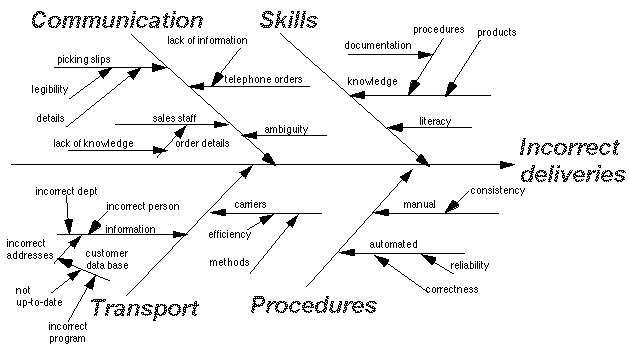
| Assignment1 Cause & Effect Diagram |
| Portfolio | Interest | Assignment1 | Assignment2 | Lab 4 | Feedback |
Cause And Effect Diagram
Purpose of Usage
It is an analysis tool that provides a systematic way of looking at effects and causes that create or contribute to those effects. It helps to assist teams in categorizing the many potential causes of problem or issues in an orderly way and in identifying root causes. Moreover, it can help to structure the quality improvement process, the diagram also depict the cause according to their importance. By mastering organization skills like working together as a team, and being open to different ideas, the diagram is a very attractive tool that is easy to learn and apply.
Historical Background
Kauro Ishikawa of Tokyo University in 1943 developed the Ishikawa Diagrams. The cause and effect diagram is also commonly known as the fishbone diagram due to its intricate appearance that resembles a fish bone. It is an important tool in helping people to identify the reasons why a process goes out of control. Dr.W.Edward Deming eventually adopted this tool in improving quality after the World War II and in his teaching of Total Quality Management since then. Both Ishikawa and Dr. Deming utilize this diagram as one of the first tools in the quality management process. The Cause & Effect (CE) diagram, also sometimes called the ‘fishbone’ diagram, is a tool for discovering all the possible causes for a particular effect. The effect being examined is normally some troublesome aspect of product or service quality, such as 'a machined part not to specification', 'delivery times varying too widely', 'excessive number of bugs in software under development', and so on, but the effect may also relate to internal processes such as 'high rate of team failures'.
How to successfully build a cause
and effect diagram?
Major categories in Cause and Effect Diagram
Causes in a cause and effect diagram are frequently arranged into four major categories.
A Typical Cause and Effect Diagram

Useful Software
Cause and effects diagrams are either drafted manually by hand on a sheet of paper, or constructed by utilizing computer software packages. Autocad, CDKEY and a variety of software can be subscripted via the Internet and be used for creating professional looking drawings and illustrations respectively. Creating the diagram is easy and also highly interactive for software user.
Recommended links